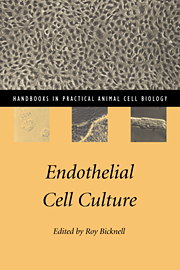Book contents
- Frontmatter
- Contents
- List of Contributors
- Preface to the series
- Acknowledgement
- 1 Introduction to the endothelial cell
- 2 Lung microvascular endothelial cells: defining in vitro models
- 3 Bone marrow endothelium
- 4 Endothelium of the brain
- 5 Isolation, culture and properties of microvessel endothelium from human breast adipose tissue
- 6 Human skin microvascular endothelial cells
- 7 Microvascular endothelium from adipose tissue
- 8 Endothelium of the female reproductive system
- 9 Synovial microvascular endothelial cell isolation and culture
- Index
5 - Isolation, culture and properties of microvessel endothelium from human breast adipose tissue
Published online by Cambridge University Press: 03 November 2009
- Frontmatter
- Contents
- List of Contributors
- Preface to the series
- Acknowledgement
- 1 Introduction to the endothelial cell
- 2 Lung microvascular endothelial cells: defining in vitro models
- 3 Bone marrow endothelium
- 4 Endothelium of the brain
- 5 Isolation, culture and properties of microvessel endothelium from human breast adipose tissue
- 6 Human skin microvascular endothelial cells
- 7 Microvascular endothelium from adipose tissue
- 8 Endothelium of the female reproductive system
- 9 Synovial microvascular endothelial cell isolation and culture
- Index
Summary
Introduction
That endothelial cells derived from different vascular organs, and from within different vascular beds within those organs, display morphological, biochemical and antigenic heterogeneity is now beyond dispute (Kumar et al, 1987; Zetter, 1988; Kuzu et al., 1992; Hewett & Murray, 1993a). This fact has highlighted the need for methods to isolate and maintain in culture endothelial cells from a variety of species and tissues. Unquestionably the richest sources of microvascular endothelial cells have been tissues such as adipose tissues and brain which, by virtue of the special physical characteristics of their parenchyma, allow the ready separation of microvessels from the bulk of the tissue. The difference in buoyant densities of adipocytes and the stromal component of adipose tissues was first exploited by Wagner & Matthews (1975) for the isolation of microvessel endothelium from the rat epididymal fat pad. Similarly, high microvessel density, ease of separation, and the resistance of the parenchyma to growth in routine culture, have made brain a relatively accessible source of microvessel endothelium (Kumar et al., 1987; Hewett & Murray, 1993a). Nevertheless the isolation of endothelial cells from more complex tissues with a wide variety of cell types, many of which readily adapt to cell culture in competition with the endothelial cell of interest, has until recently remained a significant technical problem. The development of new techniques producing relatively large numbers of pure endothelial cells has in addition led to the realisation that endothelial cells are less fastidious in terms of growth requirements than previously thought, and microvessel cells from a wide variety of tissues can now be routinely cultured.
- Type
- Chapter
- Information
- Endothelial Cell Culture , pp. 55 - 76Publisher: Cambridge University PressPrint publication year: 1996
- 1
- Cited by



